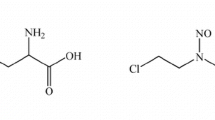Summary
We compared doxorubicin and metabolite pharmacokinetic data obtained from thin-layer chromatography (TLC) and high-performance liquid chromatography (HPLC) assay of plasma samples from six patients who had been treated with doxorubicin. Duplicate 1-ml samples were extracted with chloroform: isopropanol (1:1) and assayed using a sensitive HPLC system incorporating a dual pump gradient with tetrahydrofuran as the mobile phase and fluorescence detection. Duplicate 1-ml samples from the same specimens were assayed using a modification of a previously described TLC assay. Areas under the curve for doxorubicin by HPLC (3.36±2.30 μM · h) and TLC (4.16±2.50 μM · h) were not significantly different (P=0.5). Terminal half-life of doxorubicin by HPLC (28.0±6.98 h) and TLC (23.2±7.8) (P=0.29) and the calculated total-body clearances by HPLC (0.55±0.29 l/min) and TLC (0.45±0.23) (P=0.55) were not significantly different. Areas under the curve for doxorubicinol by HPLC (2.75±1.4 μM · h) and TLC (2.53±7.1 μM · h) (P=0.73) showed no significant differences. HPLC detected a mixed 7-deoxydoxorubicinol aglycone-doxorubicin aglycone peak, 7-deoxydoxorubicin aglycone, and two nonpolar, unidentified metabolites. TLC detected the following aglycone metabolites: doxorubicin aglycone, doxorubicinol aglycone, 7-deoxydoxorubicinol aglycone, an unidentified polar metabolite, and several unidentified nonpolar metabolites. From these data we conclude that HPLC and TLC detect concentrations of doxorubicin and doxorubicinol from human plasma equally well to concentrations of 7.0 nM (4 pmol injected doxorubicin). Aglycones do circulate in human plasma at concentrations above the detection limits of both assays. Doxorubicinol aglycone, which is detected by TLC but not by HPLC, may be formed from artifactual breakdown of doxorubicinol during TLC development. Unidentified nonpolar compounds seen on HPLC and TLC may represent further doxorubicin metabolism than previously described.
Similar content being viewed by others
References
Andrews PA, Brenner DE, Chou FTE, Kubo H, Bachur NR (1980) Facile and definitive determination of human adriamycin and daunorubicin metabolites by high-pressure liquid chromatography. Drug Metab Dispos 8: 152
Averbuch SD, Finkelstein TT, Fandrick SE, Reich SD (1981) Anthracycline assay by high-pressure liquid chromatography. J Pharm Sci 70: 265
Bachur NR, Moore AL, Bernstein JG, Liu A (1970) Tissue distribution and disposition of daunomycin (NSC-82151) in mice: fluorometric and isotopic methods. Cancer Chemother Rep 54: 89
Baurain R, Deprez-DeCampencer D, Trouet A (1979) Rapid determination of doxorubicin and its fluorescent metabolites by high-pressure liquid chromatography. Anal Biochem 94: 112
Benjamin RS, Riggs CE, Bachur NR (1973) Pharmacokinetics of and metabolism of adriamycin in man. Clin Pharmacol Ther 14: 592
Benjamin RS, Riggs CE, Bachur NR (1977) Plasma pharmacokinetics of adriamycin and its metabolites in humans with normal hepatic and renal function. Cancer Res 37: 1416
Blum RH (1975) An overview of studies with adriamycin in the United States. Cancer Chemother Rep 6: 247
Eksborg S (1978) Reversed-phase liquid chromatography of adriamycin and daunorubicin and their hydroxyl metabolites adriamycinol and daunorubicinol. J Chromatogr 149: 225
Eksborg S, Ehrsson H (1978) Liquid chromatographic determination of daunorubicin and daunorubicinol in plasma from leukemic patients. J Chromatogr 153: 211
Glode LM, Israel M, Pegg WJ, Wilkinson PM (1977) Hepatobiliary metabolism and excretion of adriamycin in man. Br J Clin Pharmacol 4: 639
Hulhoven R, Desager JP (1976) Quantitative determination of low levels of daunomycin and daunomycinol in plasma by high-performance liquid chromatography. J Chromatogr 125: 369
Israel M, Pegg WJ, Wilkinson PM, Garnick MB (1978) Liquid chromatographic analysis of adriamycin and metabolites in biological fluids. J Liquid Chromatogr 1: 795
Knott GD (1979) MLAB-A mathematical modeling tool. Comput Programs Biomed 10: 271
Peters JH, Murray JF (1979) Determination of adriamycin and aclacinomycin A in plasma by high pressure liquid chromatography and spectrophotofluorometry. J Liquid Chromatogr 2: 45
Pierce RN, Jatlow PI (1979) Measurement of adriamycin (doxorubicin) and its metabolites in human plasma using reversed phase high performance liquid chromatography and fluorescence detection. J Chromatogr 164: 471
Quattrone AJ, Ranney DF (1980) Simplified toxicologic monitoring of adriamycin, its major metabolites and nogalamycin by reverse-phase high pressure liquid chromatography. I. Analytical techniques for isolated human plasma. J Anal Toxicol 4: 12
Takakashi S, Bachur NR (1976) Adriamycin metabolism in man: evidence from urinary metabolites. Drug Metab Dispos 4: 79
Author information
Authors and Affiliations
Rights and permissions
About this article
Cite this article
Brenner, D.E., Galloway, S., Cooper, J. et al. Improved high-performance liquid chromatography assay of doxorubicin: Detection of circulating aglycones in human plasma and comparison with thin-layer chromatography. Cancer Chemother. Pharmacol. 14, 139–145 (1985). https://doi.org/10.1007/BF00434353
Received:
Accepted:
Issue Date:
DOI: https://doi.org/10.1007/BF00434353



